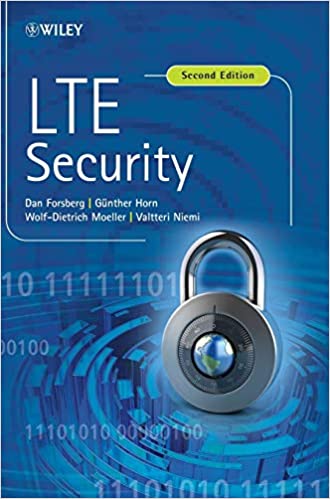LTE Security
Original price was: ₹10,364.10.₹8,291.28Current price is: ₹8,291.28.
ISBN: 9781118355589
Author/Editor: Dan Forsberg
Publisher: John Wiley
Year: 2012
3 in stock (can be backordered)
Description
A concise, updated guide to the 3GPP LTE Security Standardization specifications A welcome Revised Edition of the successful LTE Security addressing the security architecture for SAE/LTE, which is based on elements of the security architectures for GSM and 3G, but which needed a major redesign due to the significantly increased complexity, and different architectural and business requirements of fourth generation systems. The authors explain in detail the security mechanisms employed to meet these requirements. The specifications generated by standardization bodies only inform about how to implement the system (and this only to the extent required for interoperability), but almost never inform readers about why things are done the way they are. Furthermore, specifications tend to be readable only for a small group of experts and lack the context of the broader picture. The book fills this gap by providing first hand information from insiders who participated in decisively shaping SAE/LTE security in the relevant standardization body, 3GPP, and can therefore explain the rationale for design decisions in this area. * A concise, fully updated guide to the 3GPP LTE Security Standardization specifications * Describes the essential elements of LTE and SAE Security, written by leading experts who participated in decisively shaping SAE/LTE security in the relevant standardization body, 3GPP * Explains the rationale behind the standards specifications giving readers a broader understanding of the context to these specifications * Includes new chapters covering 3GPP work on system enhancements for MTC, plus application layer security in ETSI TC M2M and embedded smart card in ETSI SCP; Security for Machine-type Communication, Relay Node Security, and Future Challenges, including Voice over LTE, MTC, Home base stations, LIPA/SIPTO, and New Cryptographic Algorithms Essential reading for System engineers, developers and people in technical sales working in the area of LTE and LTE security, communication engineers and software developers in mobile communication field.
Product Properties
| Year of Publication | 2012 |
|---|---|
| Table of Contents | Preface xiii Foreword to the First Edition xv Acknowledgements xix Copyright Acknowledgements xix 1 Overview of the Book 1 2 Background 5 2.1 Evolution of Cellular Systems 5 2.2 Basic Security Concepts 10 2.3 Basic Cryptographic Concepts 13 2.4 Introduction to LTE Standardization 21 2.5 Notes on Terminology and Specification Language 26 3 GSM Security 29 3.1 Principles of GSM Security 29 3.2 The Role of the SIM 30 3.3 Mechanisms of GSM Security 31 3.4 GSM Cryptographic Algorithms 34 4 Third-Generation Security (UMTS) 37 4.1 Principles of Third-Generation (3G) Security 37 4.2 Third-Generation Security Mechanisms 40 4.3 Third-Generation Cryptographic Algorithms 49 4.4 Interworking between GSM and 3G Security 55 4.5 Network Domain Security 59 4.6 Architectures with RNCs in Exposed Locations 65 5 3G?LAN Interworking 67 5.1 Principles of 3G?LAN Interworking 67 5.2 Security Mechanisms of 3G?LAN Interworking 75 5.3 Cryptographic Algorithms for 3G?LAN Interworking 81 6 EPS Security Architecture 83 6.1 Overview and Relevant Specifications 83 6.2 Requirements and Features of EPS Security 89 6.3 Design Decisions for EPS Security 97 6.4 Platform Security for Base Stations 103 7 EPS Authentication and Key Agreement 109 7.1 Identification 109 7.2 The EPS Authentication and Key Agreement Procedure 112 7.3 Key Hierarchy 123 7.4 Security Contexts 129 8 EPS Protection for Signalling and User Data 133 8.1 Security Algorithms Negotiation 133 8.2 NAS Signalling Protection 136 8.3 AS Signalling and User Data Protection 138 8.4 Security on Network Interfaces 141 8.5 Certificate Enrolment for Base Stations 143 8.6 Emergency Call Handling 151 9 Security in Intra-LTE State Transitions and Mobility 155 9.1 Transitions to and from Registered State 156 9.2 Transitions between Idle and Connected States 157 9.3 Idle State Mobility 158 9.4 Handover 161 9.5 Key Change on the Fly 169 9.6 Periodic Local Authentication Procedure 170 9.7 Concurrent Run of Security Procedures 171 10 EPS Cryptographic Algorithms 175 10.1 Null Algorithms 176 10.2 Ciphering Algorithms 177 10.3 Integrity Algorithms 180 10.4 Key Derivation Algorithms 180 11 Interworking Security between EPS and Other Systems 183 11.1 Interworking with GSM and 3G Networks 183 11.2 Interworking with Non-3GPP Networks 193 12 Security for Voice over LTE 215 12.1 Methods for Providing Voice over LTE 215 12.2 Security Mechanisms for Voice over LTE 220 12.3 Rich Communication Suite and Voice over LTE 230 13 Security for Home Base Station Deployment 233 13.1 Security Architecture, Threats and Requirements 234 13.2 Security Features 241 13.3 Security Procedures Internal to the Home Base Station 244 13.4 Security Procedures between Home Base Station and Security Gateway 247 13.5 Security Aspects of Home Base Station Management 261 13.6 Closed Subscriber Groups and Emergency Call Handling 275 13.7 Support for Subscriber Mobility 277 14 Relay Node Security 281 14.1 Overview of Relay Node Architecture 281 14.2 Security Solution 284 15 Security for Machine-Type Communications 293 15.1 Security for MTC at the Application Level 294 15.2 Security for MTC at the 3GPP Network Level 301 15.3 Security for MTC at the Credential Management Level 306 16 Future Challenges 309 16.1 Near-Term Outlook 309 16.2 Far-Term Outlook 314 Abbreviations 319 References 327 Index 337 |
| Author | Dan Forsberg |
| ISBN/ISSN | 9781118355589 |
| Binding | Hardback |
| Edition | 2 |
| Publisher | John Wiley |
You must be logged in to post a review.






Reviews
There are no reviews yet.